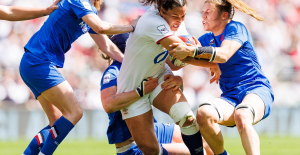"What? So close?”, the inhabitants of Estonia are said to have wondered when the Corona distance rules of 1.50 meters were announced at the time. After all, they have a lot of space in their country: With around 45,000 square kilometers, the smallest and northernmost of the three Baltic states is about the size of Switzerland, but has just 1.3 million inhabitants.
Most live in the capital Tallinn and a few other big cities, with plenty of space in between for moors, meadows, fields and forests. A largely intact nature with moose, bears and many other animals, which is ideal for active vacationers. Five Wild Possibilities.
A hike through the high moor of the Soomaa National Park can be done on boardwalks - almost on the wooden path - or cross-country over the springy ground. The latter of course only as part of a guided tour, after all it is a highly sensitive living space.
So that you don't sink up to your knees, converted snowshoes are strapped under your shoes. The wide soles ensure good progress through the landscape of moss, heather, low berry bushes and scrawny pines. The latter could be a good 50 years old, but because of the low nutrient content in the soil, they do not get beyond bonsai format, explains nature guide Triin Asi.
The wildlife biologist specializes in bears, but is also familiar with berries
The animal yield: lots of horseflies, but no mosquitoes, butterflies from the tiny tufted blue to the giant marbled white – and a hint of a moose. The long-legged mammals traverse the bog only when absolutely necessary because, at their weight, they have the same sinking rates as humans, Triin says.
There is a rest at a pond. Bathing in such a "moor eye" takes some effort, and it requires a certain technique to get into the pool, which is around three meters deep and is filled with almost black water. But it's worth it: the bath is refreshing and also good for the skin. If getting in and out is too difficult: There are also official bathing areas with benches and ladders.
Estonia has more than 2,000 islands, according to the Estonian Statistics Office. This archipelago is home to the ringed seal. During the trip with a fishing cutter from Hiiumaa, the second largest island, to the uninhabited islet of Saarnaki, where you can spend the night, you occasionally look curiously out of the water from a safe distance.
The Baltic Sea is extremely shallow here. Therefore, the last few meters have to be covered by rowing boat and finally on foot, including luggage, food, tents and sleeping bags. Then the muddy bank is reached and it goes through forest and fields to a farm that was farmed until the early 1970s.
The discovery of simplicity: there is no electricity here, and network coverage, like almost everywhere else in Estonia, where internet access is a basic right, certainly not. Water comes from a draw well, and there is an outhouse at the edge of the forest. There are no larger game on the island, so don't expect a surprise visit.
Since fresh water is scarce, after the obligatory sauna, you don't shower, but dive into the Baltic Sea. Between courses, lightly hitting the body with a tassel made of birch, juniper or even stinging nettles is said to improve blood circulation and boost metabolism. And indeed: the burning of the nettles on the skin gives way to a pleasant tingling sensation in the hot sauna air, and afterwards your back feels like a vigorous massage.
The evening ends with a driftwood campfire on the beach. After such a trip out of the comfort zone, the return trip to the mainland with the large car ferry complete with toilets and running hot water seems almost like a luxury trip.
It is estimated that there are around 1000 brown bears in Estonia. About half of those are in the north-east of the country in Alutaguse, Estonia's youngest of the six national parks, says Triin. Here her partner Bert Rähni has bought 86 hectares of forest where the animals can live in peace.
In order to finance their heart project, the two offer active and nature tours across the country as well as individual overnight stays in two bear observation huts. In an inconspicuous brown, the houses stand in a clearing. Bears have excellent senses of smell and hearing, so the huts are well sealed and have air vents six meters high.
In general, bears are very shy and should stay that way. Therefore, at best, a few fish snacks are hidden around the huts to arouse their interest and increase the chance of seeing them.
It is about two kilometers from the parking lot to the clearing. Two kilometers to be covered in silence so as not to frighten the animals. A real challenge, not just for children. Then quickly into the hut. Now whispering is allowed.
High-intensity binoculars are available. Then it's time to wait. Killing time and mosquitoes. And wait. Finally: in the last light of day, Master Petz enters the stage. However, his appearance is short-lived. In his place, a herd of wild boar takes over. And then: "Moose at the edge of the forest," reports Triin from the other side of the window. Indeed, something is moving between the dense trees. But whether it really is a moose is hard to tell for the already rather tired eyes.
The engine is at the front, the steering wheel at the back – this way the roles are clearly distributed when paddling. At least in theory. In practice, it's not that easy for the inexperienced: steering is more like braking before you unintentionally drive into the thicket of the bank again.
Luckily, the Raudna River has hardly any currents, but now and then there are thick branches in the water, which have to be circumnavigated in a somewhat artful way. And that's when water lilies and pond mummies get hit with a paddle, because somehow you have to make progress.
Rapids follow. Here the engine can rest for a moment, but you have to be careful when steering, because sometimes the underwater plants are so tall and matted that you risk losing your paddle. Meanwhile, the river landscape passes leisurely: forests, meadows, pastures with shaggy-brown animals. They turn out to be cows as you get closer.
If you are looking for a special canoeing experience, we recommend the so-called "fifth season". This is the time when the snow melts in Estonia. Then, for a few weeks, it's down land in Soomaa National Park, and the forests can't be hiked through, only paddled through.
For the Estonians, too, this is a special event that is only topped by another cold snap: when the melt water freezes again, the area can be explored on ice skates or kick sleds.
The Matsalu National Park in western Estonia is one of the most important breeding and resting areas for countless birds. Around 270 different species have already been spotted in the estuary of the Kasari River.
But this delta on the Baltic Sea is not only a paradise for ornithologists. Beavers can also be observed up close during a boat trip at dusk. The boat holds 15 people, the captain sits enthroned on an office chair fixed to the stern. From up there he has the best view of where and when a rodent might cross his path.
The ride starts in a canal, only a little wider than the boat. Reed grows to the left and right. Despite all the strained looks, no beaver anywhere. Suddenly there is a splashing sound, the captain switches off the engine, everyone looks forward to the water. And indeed: a beaver swims through the river with its head held high. His dwelling is well hidden in the reeds.
At a lookout tower on the riverbank there is a picnic on a huge boulder. Anyone who climbs the tower will be rewarded with a view far across the country. And if you look very closely through the binoculars, you will see a fox roaming around between hay bales and two grazing deer. In the fading light, the boat ride returns. Like silhouettes, dead trees stretch into the blue-pink sky on the border between evening and night.
Suddenly a roaring noise. It must have been a moose, well hidden behind a high wall of reeds.
Arrival: Direct flights to Tallinn from Frankfurt/Main or Munich with Lufthansa, connecting flights from many other German airports, for example with Air Baltic via Riga, Lot via Warsaw or Finnair via Helsinki. From the Finnish capital, ferry crossing to Tallinn is also possible with Tallink Silja (tallink.com). There are no direct ferry connections from Germany to Estonia.
Organiser: Many nature experiences, especially in the national parks, are only possible as part of a booked tour. They can also be booked individually as a travel component at NaTourEst (natourest.ee). A night in the Bärenhütte, for example, costs 115 euros. The organizer also works with various German travel providers. For example, a ten-day family tour from/to Tallinn can be booked with Renatour (renatour.de) from EUR 1799 per adult and EUR 1299 per child (6 to 14 years).
Information: Visit Estonia, visitestonia.com

 B:SM will break its investment record this year with 62 million euros
B:SM will break its investment record this year with 62 million euros War in Ukraine: when kyiv attacks Russia with inflatable balloons loaded with explosives
War in Ukraine: when kyiv attacks Russia with inflatable balloons loaded with explosives United States: divided on the question of presidential immunity, the Supreme Court offers respite to Trump
United States: divided on the question of presidential immunity, the Supreme Court offers respite to Trump Maurizio Molinari: “the Scurati affair, a European injury”
Maurizio Molinari: “the Scurati affair, a European injury” First three cases of “native” cholera confirmed in Mayotte
First three cases of “native” cholera confirmed in Mayotte Meningitis: compulsory vaccination for babies will be extended in 2025
Meningitis: compulsory vaccination for babies will be extended in 2025 Spain is the country in the European Union with the most overqualified workers for their jobs
Spain is the country in the European Union with the most overqualified workers for their jobs Parvovirus alert, the “fifth disease” of children which has already caused the death of five babies in 2024
Parvovirus alert, the “fifth disease” of children which has already caused the death of five babies in 2024 Inflation rebounds in March in the United States, a few days before the Fed meeting
Inflation rebounds in March in the United States, a few days before the Fed meeting Video games: Blizzard cancels Blizzcon 2024, its annual high mass
Video games: Blizzard cancels Blizzcon 2024, its annual high mass Falling wings of the Moulin Rouge: who will pay for the repairs?
Falling wings of the Moulin Rouge: who will pay for the repairs? “You don’t sell a company like that”: Roland Lescure “annoyed” by the prospect of a sale of Biogaran
“You don’t sell a company like that”: Roland Lescure “annoyed” by the prospect of a sale of Biogaran Exhibition: in Deauville, Zao Wou-Ki, beauty in all things
Exhibition: in Deauville, Zao Wou-Ki, beauty in all things Dak’art, the most important biennial of African art, postponed due to lack of funding
Dak’art, the most important biennial of African art, postponed due to lack of funding In Deadpool and Wolverine, Ryan and Hugh Jackman explore the depths of the Marvel multiverse
In Deadpool and Wolverine, Ryan and Hugh Jackman explore the depths of the Marvel multiverse Tom Cruise returns to Paris for the filming of Mission Impossible 8
Tom Cruise returns to Paris for the filming of Mission Impossible 8 Skoda Kodiaq 2024: a 'beast' plug-in hybrid SUV
Skoda Kodiaq 2024: a 'beast' plug-in hybrid SUV Tesla launches a new Model Y with 600 km of autonomy at a "more accessible price"
Tesla launches a new Model Y with 600 km of autonomy at a "more accessible price" The 10 best-selling cars in March 2024 in Spain: sales fall due to Easter
The 10 best-selling cars in March 2024 in Spain: sales fall due to Easter A private jet company buys more than 100 flying cars
A private jet company buys more than 100 flying cars This is how housing prices have changed in Spain in the last decade
This is how housing prices have changed in Spain in the last decade The home mortgage firm drops 10% in January and interest soars to 3.46%
The home mortgage firm drops 10% in January and interest soars to 3.46% The jewel of the Rocío de Nagüeles urbanization: a dream villa in Marbella
The jewel of the Rocío de Nagüeles urbanization: a dream villa in Marbella Rental prices grow by 7.3% in February: where does it go up and where does it go down?
Rental prices grow by 7.3% in February: where does it go up and where does it go down? Even on a mission for NATO, the Charles-de-Gaulle remains under French control, Lecornu responds to Mélenchon
Even on a mission for NATO, the Charles-de-Gaulle remains under French control, Lecornu responds to Mélenchon “Deadly Europe”, “economic decline”, immigration… What to remember from Emmanuel Macron’s speech at the Sorbonne
“Deadly Europe”, “economic decline”, immigration… What to remember from Emmanuel Macron’s speech at the Sorbonne Sale of Biogaran: The Republicans write to Emmanuel Macron
Sale of Biogaran: The Republicans write to Emmanuel Macron Europeans: “All those who claim that we don’t need Europe are liars”, criticizes Bayrou
Europeans: “All those who claim that we don’t need Europe are liars”, criticizes Bayrou These French cities that will boycott the World Cup in Qatar
These French cities that will boycott the World Cup in Qatar Euroleague: at the end of the suspense, Monaco equalizes against Fenerbahçe
Euroleague: at the end of the suspense, Monaco equalizes against Fenerbahçe Women's Six Nations: Where to see and five things to know about France-England
Women's Six Nations: Where to see and five things to know about France-England Liverpool: it is confirmed, Slot will succeed Klopp on the Reds bench
Liverpool: it is confirmed, Slot will succeed Klopp on the Reds bench Ligue 1: Montpellier and Nantes back to back, two reds in stoppage time
Ligue 1: Montpellier and Nantes back to back, two reds in stoppage time


















